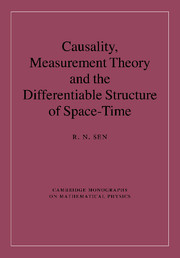Book contents
- Frontmatter
- Contents
- Preface
- Acknowledgements
- To the reader
- Prologue
- Part I Causality and differentiable structure
- Introduction to Part I
- 1 Mathematical structures on sets of points
- 2 Definition of causality on a structureless set
- 3 The topology of ordered spaces
- 4 Completion of ordered spaces
- 5 Structures on order-complete spaces
- Part II Geometrical points and measurement theory
- Mathematical appendices
- List of Symbols for Part I
- References
- Index
2 - Definition of causality on a structureless set
Published online by Cambridge University Press: 04 August 2010
- Frontmatter
- Contents
- Preface
- Acknowledgements
- To the reader
- Prologue
- Part I Causality and differentiable structure
- Introduction to Part I
- 1 Mathematical structures on sets of points
- 2 Definition of causality on a structureless set
- 3 The topology of ordered spaces
- 4 Completion of ordered spaces
- 5 Structures on order-complete spaces
- Part II Geometrical points and measurement theory
- Mathematical appendices
- List of Symbols for Part I
- References
- Index
Summary
In the following we shall assume that the space, time and space-time of physics are made up of ‘points’ in the sense of Euclidean geometry. This assumption has been questioned by Wigner since 1952, and his reservations will be the subject of Part II of this book.
We shall begin by defining the notion of causality (which we shall call Einstein–Weyl causality) on a set of points devoid of any mathematical structure. It will be defined as a partial order on the set. Our point of departure is the observation that the propagation of a light ray determines a total order (the past-future order) on its path. We shall try to build up the causal structure by abstraction from the intersection properties of these paths in Minkowski space, and in real life.
Light rays
The fundamental objects in our scheme will be:
(i) A nonempty set of points M.
(ii) A distinguished family of subsets of M, called light rays.
The fundamental relation in our scheme will be a total order defined on the light rays.
We shall use the term light ray as a shorthand for the space-time path of a light ray; more precisely, for a mathematical abstraction from the corresponding physical concept. Light rays will generally be denoted by the letter l. A light ray through the point x will be denoted by lx, one through the points x, y by lx, y.
- Type
- Chapter
- Information
- Publisher: Cambridge University PressPrint publication year: 2010

